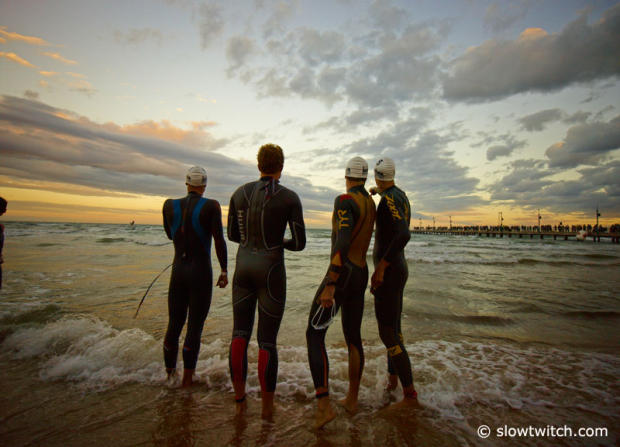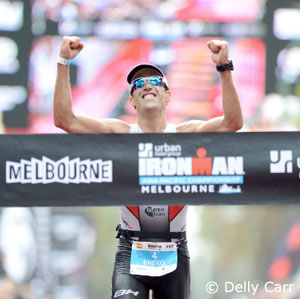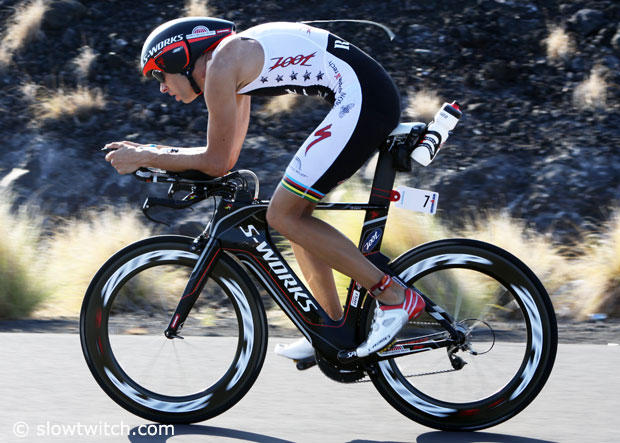Fettell vs Rapp in Melbourne
Today we compare the power data of Jordan Rapp and Clayton Fettell during the 2013 Urban Hotel Group Ironman Melbourne and here is the analysis of AJ Johnson of TrainingPeaks.
The second running of Ironman Melbourne was supposed to look like this: Australian super swim/biker Clayton Fettell would come out of the water with a lead, then hammer the bike. Behind him, Craig Alexander, Marino Vanhoenacker and Jordan Rapp would have to catch up. But the weather changed things for everyone. Due to serious gale winds and white caps, the swim was shortened to a 1.9-km single loop. We expected to see a contrast in styles – the "go for broke, leave it out on the bike" tactic of Fettell against the patient, metronomic pacing of Rapp. Instead, this year Fettell and Rapp had as many similarities as differences.
View Fettell’s SRM power data within TrainingPeaks: http://tpks.ws/9s62
View Rapp’s Quarq power data within TrainingPeaks: http://tpks.ws/1iT7
Fettell still lead out of the water, with fellow Aussie Joey Lampe with him. Less than one minute later, Alexander and Eneko Llanos emerged, followed by Vanhoenacker another 45 seconds back. So early on, Fettell had to make a choice – go hard or be absorbed by the pack. Unlike his other two long-course races, Fettell didn’t attempt to ride off the front. "The short swim changed the dynamic of the race so I just rode in the front group," said Fettell afterwards. That doesn’t mean he was taking it easy. His SRM power meter showed that his 20 minute peak power occurred just 16 minutes into the race, where he held 320w, or 4.1 watts per kilogram (w/kg). Considering his FTP is 380w, a massive 4.88 w/kg, (as reported by Fettell), that’s essentially 84 percent of his FTP.

Fettell's power data as shown in TrainingPeaks

Behind the front group, Rapp was burning up the pavement to make contact. The rough water put Rapp over 4 minutes back of Fettell, and 3 behind Alexander. So while the front pack was forming, Rapp was out of the game. Like Fettell, Rapp’s peak 20 minute power came early – as in, right from the start. His Quarq power data shows that he motored a huge 4.74 w/kg, holding 333w for 20 minutes! With an FTP of 366w, an astounding 5.2 w/kg, (as reported by Rapp), that’s 91 percent of his FTP. We expected to see Fettell put out this number to get away, so it was a bit surprising to see it come from Rapp. Even with these high numbers, Rapp was not able to attach himself to the front group.

Rapp in action on the course in Melbourne – riding alone.

One of the best metrics to compare athletes in an "apples to apples" manner is by looking at their watts/kg. When we look at the data, you can see that Rapp put out 4.0 w/kg, exactly what he did in Kona. This is a solid number and what we expect to see from the top men. When you look at the bike course as two loops of a double out-and-back, Rapp put out 4.3 w/kg for the first 56 miles, then 3.8 w/kg for the back half. This difference is due to Rapp’s chasing effort early on. Looking into more detail, in the first 28 miles Jordan held 4.5 w/kg with 316w. The second time Rapp rode into the wind, miles 56-84 roughly, he still cranked out 3.98 w/kg with 280w. Fettell, on the other hand, averaged 3.6 w/kg for the whole ride, a bit lower than we typically expect for his group of peers, but one thing to note is that Fettell made a conscious decision to add weight for this race. He came in at 8 kilos, or 17 pounds heavier than in his past races! As far as pacing goes, Fettell averaged 3.7 w/kg in the first lap and 3.49 w/kg the second lap.

The first time into the wind, he averaged 3.9 w/kg, then 3.8 w/kg the second time through. Without knowing the details, it is hard to say how much of this is due to Fettell being in the front group and working with others and Rapp trying to catch up. Interestingly, despite his higher numbers, Rapp was losing time in the latter miles.
Both riders used the last miles to set up for the run. With a screaming tailwind from mile 28 to 56, Rapp held 277w, 3.9 w/kg, and a speed of 29.5 mph . Fettell held 276w, 3.5 w/kg, and also held 29.5 mph on the same stretch. The second time around, coming into T2, both athletes backed off and likely took in calories to get ready to run. For the last 28 miles, Rapp held 248w, 3.5 w/kg, at 26.8 mph. Fettell held 243w, or 3.1 w/kg, and was also at 26.9 mph. Backing off to get calories in was wise, though it definitely affected the data, especially when looking at the laps. This is an example of using your power meter as a guide, not as an absolute authority. Could both athletes have held more power? Probably, but racing (an Ironman or not) isn’t about the numbers you download.
Known for his detail-oriented approach, Rapp has always had one of the better aero positions among the pros. So, despite putting out less total watts and watts per kilogram, Fettell held the same speed. This shows that Fettell is another rider that has maximized his position.
Other similarities to note: both Rapp and Fettell kept their wattage output even. The Variability Index, or VI, measures how much you surge and slow, or pedal steady. If you hit the gas then slow, your VI will be above 1.0. If you put out a steady effort, your VI will be right at 1. Basically, the closer to 1 your VI, the better. This is key for Ironman racing, where surging can burn glycogen at a faster rate – Joe Friel likes to see a VI of less than 1.06 for an Ironman. For a flatter course like Melbourne, this is pretty easy, but the head/tail wind scenario that was present on race day could have made it interesting. Both athletes kept their effort even throughout with little to no spikes. Rapp held a 1.03 VI and Fettell was at 1.05 for the entire 112 miles. Broken down further, you can view VI for any segment. Impressively, when broken down into two laps, Fettell’s VI is 1.05 for both.
One difference is in their chosen cadence. Fettell pedaled at what most feel is the "most efficient" cadence for IM racing, 90 RPM’s for the entire leg. Rapp has done his own testing and found that he is better with a lower cadence (he doesn’t leave anything to chance). Rapp averaged 77 RPM’s, but broken into laps he was at 80 RPM’s in the first lap and dropped to 75 RPM’s in the second. You can’t argue with his choice, as he was able to run his way to 4th with a 2:52 marathon.

One last important data point – Rapp finished in 7:50:54 and Fettell crossed the line at 8:03:19. That’s only a 2.5 percent of difference in overall time. With all this data, it is still important to note that both athletes had to make last-minute decisions on race day. For Fettell, his original game plan was gone from the start with the shortened swim. He emerged at the front, then played his best card by trying to work with the front pack rather than trying to fly off the front. Though it didn’t fully work out for him, it proves that Fettell is learning the Ironman game and adapting his strategy for better performances. Rapp showed his smarts and consistency again. Just like Kona, and even IM NYC, Rapp put out his usual 4.0 watts/kg to ride himself into a good position starting the run. These numbers give us further insight into how these riders get every last bit out of their bodies to compete at the highest level of the sport.






